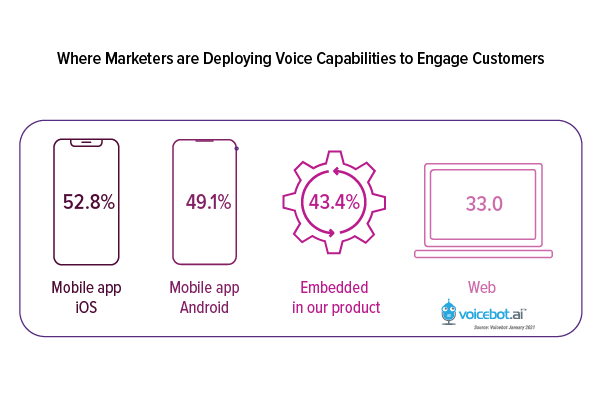Where Custom Voice Assistants are Deployed in 2021
Marketers have increased their development of owned or custom voice assistants over the past two years and smartphones are the most common surface for deployment. Custom voice assistants are operated by a company — often a consumer brand — and connect directly with users unlike voice apps that are intermediated by Amazon Alexa, Google Assistant, or Samsung Bixby. These custom assistants are typically used by consumers but some are implemented internally for employees to increase productivity.

Voicebot’s biannual The State of Voice Assistants as a Marketing Channel report delved deeply into the sentiment and activities of marketers in 2021 around the idea of deploying their own custom voice assistants. One interesting finding was that about half of these assistants are made available through mobile apps with Apple iOS a slightly more popular choice than Android. No far behind at 43.4% were companies that embedded custom voice assistants in their own products. The web was the fourth most popular digital channel at 33.0%.
This result closely aligns with marketer sentiment about where it is most important to implement voice apps. Smartphones were also the top choice of marketers followed by smart speakers and automobiles.
The Rise of the Owned Custom Voice Assistants
Voicebot predicted in early 2019 that the success of Amazon Alexa and Google Assistant would serve as an objective example to other companies about how valuable it can be to have your own voice assistant. Many of the companies building their own voice assistant also have an Alexa skill or Google Assistant Action. That experience showed them the usefulness of those voice ecosystem channels as well as their limitations. The shift to making their own custom voice assistant available was initially motivated by an interest in having greater control over the customer experience, features, and data.
This rising interest coincided with improved quality and declining cost for many of the components required to build a custom voice assistant. Google and Amazon not only have their own voice assistants but they along with others compete to provide voice assistant technology to companies building their own experiences. That competition and an interest in being an AI-vendor-of-choice, is driving more innovation while keeping prices down. There has never been a better time to build your own voice assistant.
While many brands are building their assistants using off-the-shelf technology, several have gone further and acquired promising startups to assert even more control over their efforts. Peloton’s recent acquisition of Aiqudo follows purchases by Snapchat of Voca.ai and Cisco of Voicea just to name a few. Voice assistants are proliferating and marketers are often the catalysts behind these efforts.
Learn More About Marketer Voice Tech Activity
In Voicebot’s most recent report, you can learn more about how marketers are approaching custom assistants as well as views about voice commerce, Amazon and Google, key features built into voice apps and much more. There are over 25 charts and 35 pages of analysis in the report. Some of the charts in the report include:
- Marketer Optimism About Voice Product Search 2019-21
- Marketer Optimism About Voice Commerce 2019-21
- Marketer View of Which Consumer Assistant Has the Most Potential Today 2019-21
- Brand and Enterprise Marketer View of Consumer Voice Assistant with the Most Potential Today
- Marketer View of Which Voice Assistant Has the Most Long-term Potential 2019-21
- Relative Share of Voice Assistants Adopted by Marketers 2019-21
- Types of Voice Apps Launched by Marketers 2019-21
- Brand Marketer Voice App Objectives 2019-21
- Marketer Expectations for Voice App Budgets 2019-21
- Voice App Investments Change by Year 2019-21 (breakout by Amazon Alexa, Apple Siri, Google Assistant, Samsung Bixby, Owned Custom Assistants)
- Enterprise Marketer Drivers of Voice Assistant Budgets
- Frequency of Vendor Evaluation and Selection for Custom Voice Assistants
- Technology Selection Criteria for Owned Custom Assistants
- Where Marketers are Deploying Voice Capabilities to Engage Customers
- Marketer Objectives for Building Custom Voice Capabilities and Assistants
- Marketers’ Voice App Sonic Branding Choices 2019-21
- Marketers with a Sonic/Audio Branding Strategy 2019-21
- …and many more
Follow @bretkinsellaFollow @voicebotai
Marketers Favor Smartphones for Voice Apps but Big Companies Still Like Smart Speakers – New Report
Marketers Assign Higher Importance to Voice Assistants as a Marketing Channel in 2021 – New Report
Voice Assistant Use on Smartphones Rise, Siri Maintains Top Spot for Total Users in the U.S.








